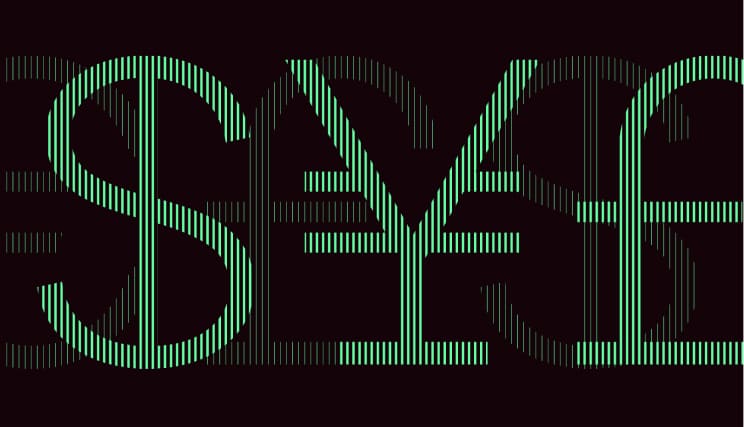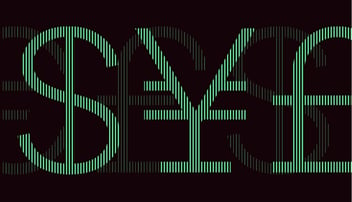Gain an overview of the latest developments on the currency market and anticipate fluctuation risks.
It’s hard to go back
The back-to-school period is hard for everyone, but even more so for central bankers. They were already having to deal with uncomfortably high inflation. Today, they also face a slowdown that, in the eurozone, looks very likely to tip into a recession. In September, they will have to choose between a monetary policy pause and continued monetary tightening. Even though economic signals are negative, there is no prospect of a rate cut. This only applies to a minority of emerging countries at present.
The pair of the month
EUR/USD
High: 1.1085 Low: 1.0788 Change: -1.39%
The eurozone could hardly have ended the summer on a worse footing, with a plunge in PMI activity indices, a fall in the IFO business confidence index in Germany and a weakening of the job market. All this paints the picture of an economy in recession in the third quarter and lends credence to a possible monetary policy pause by the European Central Bank in September. This, in any case, is the option preferred by currency markets at this stage. In the wake of weak August indicators, the EUR/USD fell below its 200-day moving average to 1.0805. This is an important technical signal that corroborates the scenario of a continued downward trend.
EUR/GBP
High: 0.8670 Low: 0.8513 Change: -0.44%
What is so great about sterling is its resilience regardless of what happens on the economic front. UK data are poor. August PMIs attained their lowest level since January 2021 at the height of the lockdown! This is consistent with a 0.2% drop in GDP in the third quarter. And yet sterling’s performance has been quite respectable. We doubt that even a possible recession in the UK could have material adverse consequences on the UK currency.
GBP/USD
High: 1.2961 Low: 1.2579 Change: -0.92%
A weak month for sterling, which fell in August below its support level of 1.2620 (lower end of the trading range in recent weeks). This opens the door to an accentuation of the decline, with a potential drop to around 1.24 over the coming weeks. In the long term, we remain convinced that the pair still has much upside potential, but since there is still considerable uncertainty about the trajectory of UK monetary policy in the short term, the market is cautious. What’s more, long positions in sterling have been extreme for the past several weeks. A market rebalancing is inevitable eventually.
EUR/CNH
High: 8.0048 Low: 7.8439 Change: +0.10%
China is in a poor state. In the past, the country would use the yuan’s exchange rate as a rapid and effective stimulus lever. A drop in the currency’s exchange rate boosts the price competitiveness of Chinese firms. That is the theory. The reality is more complex. The Chinese central bank’s latest interventions have not aimed to lower the yuan but to strengthen it against the US dollar. This sheds light on an intense debate within the government about what strategy to adopt for the currency. The episode of August 2015 (triple devaluation of the yuan) is still in everyone’s memory. This led to a massive capital flight that was very difficult for Beijing to end. In the short term, it is clear that the yen will depreciate, but little by little and not in a linear manner. The central bank will probably continue to make regular interventions in the money market when it considers the currency’s depreciation to be too rapid. But a devaluation is not on the cards or would be the symptom of a failure of capital controls.
EUR/CHF
High: 0.9640 Low: 0.9515 Change: -0.33%
This pair has a fairly limited playing field. The trading zone in August barely surpassed 100 pips. The underlying trend is still downward in our view (especially in light of the rapid deterioration in the eurozone economy). But new indicators or a status quo at the European Central Bank meeting in September will be necessary for this decline to accelerate. In the very short term, stability is the predominant trend.
EUR/CAD
High: 1.4797 Low: 1.4484 Change: +0.23%
Canada had a monetary policy pause last January and was subsequently obliged to start raising interest rates again to tackle rampant inflation. This pause was undoubtedly a mistake. Inflation continues to rise, reaching 3.3% year-on-year in July (up sharply from June). The Bank of Canada will be forced to intervene, and this may marginally boost the Canadian dollar.
EUR/AUD
High: 1.7040 Low: 1.6262 Change: +0.65%
The pair staged an impressive rally in August, but we anticipate some profit taking (this has already begun). The currency markets are also starting to price in a monetary policy pause in Australia, which has undoubtedly put a little drag on the AUD’s momentum (not to mention the economic downturn in China, a notable factor worth mentioning). The latest Australian economic data are weak. Activity in the private sector continued to fall in August according to preliminary figures (PMI at 47.1 versus 48.2 in July). New orders also plunged for the first time in five months. The effects of monetary policy are now being clearly felt on activity.
EUR/JPY
High: 160.18 Low: 151.37 Change: +0.19%
If you took advantage of August to steer clear of the currency market, you missed nothing regarding the EUR/JPY pair. The monthly low point (151.37) was the same as last month. Japanese monetary policy is still unchanged. A large majority of economists forecasts that the Bank of Japan will leave its monetary policy unchanged at least until July 2024 (Reuters survey last week). Lastly, the central bank has not made any interventions in the currency market. The door is open to a steeper depreciation of the yen in the coming months.
EUR/HUF
High: 394.61 Low: 378.83 Change: -2.01%
The euro has suffered from weak indicators pointing to a recession in the eurozone, which explains in large part the currency’s depreciation in August against the HUF. In the short term, we need to pay more attention to what happens in the eurozone and at the European Central Bank than in Hungary, in particular since Hungarian monetary policy is likely to be in autopilot mode from September after a 100-point hike in the policy rate at the end of August. We do not rule out the possibility of the HUF clawing back a little ground in the months ahead. Part of the Hungarian currency’s depreciation is explained by probably misplaced expectations of rates cuts by the central bank. It seems unlikely that a monetary loosening cycle will begin in the fourth quarter as the currency markets seem to believe.
USD/HUF
High: 361.14 Low: 345.61 Change: -0.68%
We tend to think the US dollar is in a better position than the HUF in this second half-year. The US economy is solid, there is no recession in sight and, even if interest rates are not raised further, carry trade strategies that boosted the HUF in the first part of the year are likely to start losing importance in determining the trajectory of the USD/HUF pair. This is partly explained by the fact that the Hungarian central bank will probably be in autopilot mode from September, leaving its interest rates unchanged.
Economic Calendar
| DATE | CURRENCY | EVENT |
| 01/09 | USD | US employment figures for August |
| 05/09 | AUD | Central bank meeting |
| 06/09 | USD | ISM non-manufacturing index for August (services sector) |
| 14/09 | EUR |
Central bank meeting followed by a press conference
|
| 20/09 | USD |
Central bank meeting
|
|
|
||
| 25/09 | HUF |
Central bank meeting |
Topics




